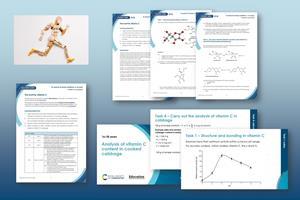How does cooking affect the presence of vitamin C in cabbage?
If cabbage is not cooked carefully the ascorbic acid (vitamin C) is broken down by the enzyme ascorbic oxidase. The secret of preparing nutritious cabbage is to plunge it rapidly into boiling water which inactivates this enzyme. Nevertheless, more than 50% of the vitamin C will be leached out into the water and therefore lost unless the liquid is used as an ingredient in another item on the menu.

Download this
Context-based problem-solving practical activity, for age range 16–18
Plan a redox titration to investigate the effect of cooking methods on vitamin C in cabbage.
Resources include:
This resource accompanies the article Vital vitamins in Education in Chemistry which explores the need for vitamin supplements in a healthy balanced diet. The resource has been adapted from the book series In search of more solutions, which aims to engage and motivate learners through context-based problems.
Learning objectives
- Apply the practical techniques of preparing a standard solution and carrying out a titration to analyse the mass of vitamin C in cooked cabbage.
- Plan a practical method for your analysis from partial instructions, taking into account health and safety considerations and required accuracy and precision.
- Record, analyse and present data to reach a conclusion from your results.
- Apply concepts of redox, solubility, enzyme and numerical chemistry to the analysis of vitamin C in cabbage.
How to use this resource
Use the resource flexibly depending on the time available and the type of activity and assessment your learners require. Some suggestions are:
- Set learners Tasks 1 and 2 to work on independently then carry out Task 3 and Task 4 in groups.
- Set learners Tasks 1 to 3 only to give them experience of planning a practical method.
- Cover the theory for Tasks 1 and 2 as a plenary in class and provide learners with the practical method to carry out Task 4.
- With a large class, ask learners to weigh out 100 g of cabbage which is already shredded.
- Use tasks from either the student support or student challenge sheets depending on the experience of the group.
- Use the presentation slides to discuss the tasks in class.
Differentiation
Two versions of the student sheet are available. Both address the learning objectives and success criteria outlined in the teacher notes.
The student support sheet, indicated by the file name and one star in the learner-facing worksheet header, offers more support by:
- Providing hints alongside questions.
- Presenting some questions as multiple choice.
- Emphasising key terms in bold.
- Presenting calculations in structured stages.
The student challenge sheet, indicated by the file name and two stars in the learner-facing worksheet header, offers less support and questions are more open-ended. In particular, Task 3 requires learners to draw on their practical knowledge and experience to plan the analysis of vitamin C in cooked cabbage.
Technician notes
Read our standard health and safety guidance and carry out a risk assessment before running any live practical.
See the technician notes for detailed preparation, hazard and disposal information. This is an open-ended problem-solving activity, so the guidance given here is necessarily incomplete. Read the student sheets for partial instructions to carry out the experiment. Remind learners to wear their safety glasses and to take care to avoid getting the solutions on their skin.
Although not essential, during trialling, some institutions used a fume cupboard to reduce the smell of overcooked cabbage
Answers
Answers are provided in the teacher notes.
More resources
- Vitamin C in fresh orange juice degrades over time due to oxidation. The rate of degradation can be slowed down by refrigeration, extending the shelf life. Use this as a context for teaching rates of reaction at post-16.
- Do vitamin pills work? Analyse data about the effects of vitamin C and explore how science gives rise to different viewpoints in this lesson plan with activities for 14–16 year olds.
- Measure the amount of vitamin C in learners’ favourite fruit drinks with a titration and calculations.
- Find out how Olivia, a senior laboratory technician, ensures that food products contain what they claim to and are also safe to eat for people with allergies.
Extension
You could carry out experiments to find other cooking methods’ effects on the vitamin C content of cabbage – eg samples could be stir-fried, microwaved or steamed. You could also use the techniques in the tasks to find out how freezing affects the nutritional value of cabbage.
Freezing slows down deterioration because of the inactivation of the enzymes. However, if the blanching process is carried out correctly, before freezing, the enzymes should be destroyed.
Downloads
Vitamin C content of cabbage student challenge sheet
Handout | PDF, Size 0.42 mbVitamin C content of cabbage student support sheet
Handout | PDF, Size 0.45 mbVitamin C content of cabbage teacher notes and answers
Handout | PDF, Size 0.28 mbVitamin C content of cabbage technician notes
Handout | PDF, Size 0.15 mbVitamin C content of cooked cabbage slides
Presentation | PDF, Size 0.89 mbVitamin C content of cabbage student challenge sheet
Editable handout | Word, Size 0.64 mbVitamin C content of cabbage student support sheet
Editable handout | Word, Size 0.65 mbVitamin C content of cabbage teacher notes and answers
Editable handout | Word, Size 0.47 mbVitamin C content of cabbage technician notes
Editable handout | Word, Size 56.32 kbVitamin C content of cooked cabbage slides
Presentation | PowerPoint, Size 1.89 mb
Additional information
This resource was originally published in the book In Search of More Solutions. It was updated in 2023 by Nora Richardson.


















No comments yet